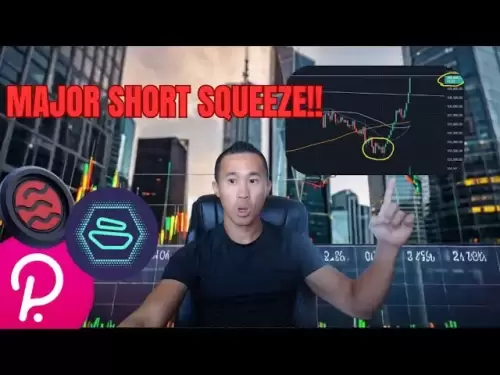-
 Bitcoin
Bitcoin $108,270.9768
2.07% -
 Ethereum
Ethereum $2,489.8066
2.50% -
 Tether USDt
Tether USDt $1.0004
0.01% -
 XRP
XRP $2.2035
0.66% -
 BNB
BNB $661.6608
2.32% -
 Solana
Solana $150.6425
2.13% -
 USDC
USDC $0.9999
-0.01% -
 TRON
TRON $0.2810
0.90% -
 Dogecoin
Dogecoin $0.1645
3.05% -
 Cardano
Cardano $0.5743
4.91% -
 Hyperliquid
Hyperliquid $38.8419
-0.15% -
 Bitcoin Cash
Bitcoin Cash $504.3134
-2.64% -
 Sui
Sui $2.8096
4.35% -
 Chainlink
Chainlink $13.3095
2.21% -
 UNUS SED LEO
UNUS SED LEO $8.9469
0.33% -
 Avalanche
Avalanche $17.9231
3.93% -
 Stellar
Stellar $0.2340
0.74% -
 Toncoin
Toncoin $2.8458
3.21% -
 Shiba Inu
Shiba Inu $0.0...01158
3.47% -
 Litecoin
Litecoin $86.0738
1.94% -
 Hedera
Hedera $0.1507
2.99% -
 Monero
Monero $319.8544
2.31% -
 Polkadot
Polkadot $3.4081
1.95% -
 Dai
Dai $1.0000
0.01% -
 Bitget Token
Bitget Token $4.5645
0.91% -
 Ethena USDe
Ethena USDe $1.0002
0.00% -
 Uniswap
Uniswap $7.2959
5.27% -
 Aave
Aave $272.4623
2.90% -
 Pepe
Pepe $0.0...09680
2.96% -
 Pi
Pi $0.4955
0.78%
Stop loss setting of Bitcoin contract
Traders seeking to protect their Bitcoin contract investments from unexpected losses should implement stop-loss orders, carefully considering their risk tolerance, market levels, and contract size to ensure effective risk management.
Nov 20, 2024 at 08:00 am

Stop Loss Setting of Bitcoin Contract
Introduction
The cryptocurrency market is renowned for its volatility, and Bitcoin (BTC), the largest and most well-known cryptocurrency, is no exception. Sharp price swings and sudden market reversals are common in the Bitcoin market, making it imperative for traders to implement effective risk management strategies. A stop-loss order is a crucial tool for managing risk and protecting against significant losses. This comprehensive guide will delve into the intricacies of stop loss setting for Bitcoin contracts, empowering traders to navigate the tumultuous waters of the cryptocurrency markets with greater confidence and resilience.
Understanding Stop Loss Orders
A stop-loss order is an instruction to a trading platform to automatically sell a Bitcoin contract when the market price falls below a predetermined level. It serves as a safety mechanism, ensuring that losses are limited to a manageable amount. By setting a stop-loss order, traders define the maximum acceptable loss for a particular trade and safeguard their capital from potentially catastrophic price movements.
Benefits of Using Stop Loss Orders
- Risk Management: Stop-loss orders help traders mitigate risk by limiting their exposure to market volatility and potential losses. Sudden market downturns or unexpected events can lead to substantial losses, which can be significantly reduced by implementing stop-loss orders.
- Preservation of Capital: By predetermining the maximum loss for a trade, stop-loss orders protect traders' capital from excessive drawdowns. In volatile markets, stop-loss orders act as a shield, preventing traders from losing more than they can afford.
- Discipline: Stop-loss orders instill discipline in traders' trading behavior. By setting a clear price level for exiting trades, traders avoid emotional decision-making and adhere to their predetermined risk appetite.
- Peace of Mind: Stop-loss orders provide traders with peace of mind, knowing that their trading activities are protected against unforeseen market movements. This allows traders to step away from their trading screens without worrying about potentially catastrophic losses.
How to Set a Stop Loss Order
- Determine Your Risk Tolerance: Before setting a stop-loss order, traders must assess their risk tolerance and determine the maximum amount of loss they are willing to accept for a particular trade. Risk tolerance varies among individuals and should be carefully considered based on financial circumstances, investment objectives, and psychological resilience.
- Identify Market Levels: Stop-loss orders should be placed at strategic market levels that align with technical analysis, support and resistance levels, or major moving averages. Traders can utilize charting tools and market indicators to identify potential pivot points where the trend is likely to reverse.
- Calculate Contract Size: The number of contracts traded should be carefully calculated to ensure that the maximum loss does not exceed the predetermined risk tolerance. Contract size should be adjusted according to account balance, risk appetite, and the volatility of the underlying asset.
- Set the Stop-Loss Price: Once the risk tolerance, market levels, and contract size have been determined, traders can set the stop-loss price. This price level should be placed below the entry price to limit potential losses, considering the volatility of the market and potential slippage.
- Monitor and Adjust: Stop-loss orders are not static and should be monitored and adjusted as market conditions change. Traders should periodically review their stop-loss levels and make necessary adjustments based on market movements and evolving risk tolerance.
Types of Stop Loss Orders
- Market Stop-Loss Order: A market stop-loss order triggers an immediate sell order at the current market price when the specified trigger price is reached. This type of order is suitable for volatile markets and when immediate execution is required.
- Limit Stop-Loss Order: A limit stop-loss order triggers a sell order at a predetermined limit price when the specified trigger price is reached. This type of order offers more control over the execution price and is preferable in less volatile markets or when slippage is a concern.
Best Practices for Stop Loss Setting
- Use Realistic Trigger Prices: Stop-loss orders should be placed at realistic market levels that take into account potential price volatility and slippage. Setting overly tight stop-loss orders may lead to premature exits, while placing them too far away may not provide adequate protection against losses.
- Consider Market Volatility: The volatility of the underlying asset should be considered when setting stop-loss orders. More volatile assets require wider stop-loss levels to accommodate price fluctuations, while less volatile assets may allow for tighter stop-loss levels.
- Manage Risk Progressively: Traders should gradually increase their stop-loss levels as the position moves in their favor. This progressive approach locks in profits while maintaining a degree of downside protection.
- Avoid Overtrading: Overtrading can lead to excessive risk exposure and increased vulnerability to losses. Traders should avoid putting on too many positions and ensure that their stop-loss orders are commensurate with their risk tolerance and account balance.
- Educate Yourself Continuously: Stop loss setting is an art that requires continuous learning and adaptation. Traders should regularly educate themselves on market dynamics, trading strategies, and risk management techniques to improve their decision-making and optimize their stop loss strategies.
Disclaimer:info@kdj.com
The information provided is not trading advice. kdj.com does not assume any responsibility for any investments made based on the information provided in this article. Cryptocurrencies are highly volatile and it is highly recommended that you invest with caution after thorough research!
If you believe that the content used on this website infringes your copyright, please contact us immediately (info@kdj.com) and we will delete it promptly.
- TRON DeFi Swaps in 2025: SunSwap and JustLend's Impressive Growth
- 2025-07-03 04:30:12
- Ripple's Bold Moves: Bank License, Fed Master Account, and Stablecoin Ambitions
- 2025-07-03 04:30:12
- Bitcoin Price Eyes New ATH After Bullish Cup-and-Handle Breakout
- 2025-07-03 04:35:13
- Bitcoin Price Eyes New All-Time High: Quarterly Candle Signals Bull Run?
- 2025-07-03 04:40:12
- NFTs, Smart Contracts, and Creation: Unleashing Digital Sovereignty, Ya Dig?
- 2025-07-03 04:45:13
- GalaChain SDK 2.0: Revolutionizing Web3 Development, One Streamlined API at a Time
- 2025-07-03 03:50:12
Related knowledge

How to identify the contract value range in combination with the market profile?
Jul 02,2025 at 10:56pm
Understanding the Market ProfileTo effectively identify the contract value range in combination with the market profile, it's essential to first understand what each concept entails. The market profile is a framework that helps traders visualize how price and time interact across a given period, typically a trading day or session. It provides insights i...

How to use the price slope to filter the false breakthrough signal of the contract?
Jun 20,2025 at 06:56pm
Understanding the Concept of Price Slope in Contract TradingIn contract trading, especially within cryptocurrency derivatives markets, price slope refers to the rate at which the price changes over a specific time period. It helps traders assess the strength and sustainability of a trend. A steep slope may indicate strong momentum, while a shallow slope...

How to determine the expected volatility of the contract through the volatility cone?
Jun 19,2025 at 12:28pm
Understanding the Basics of Volatility in Cryptocurrency ContractsIn the realm of cryptocurrency trading, volatility is a key metric that traders use to assess potential risk and reward. When dealing with futures contracts, understanding how volatile an asset might become over time is crucial for position sizing, risk management, and strategy developmen...

How to formulate a contract intraday trading plan in combination with the pivot point system?
Jun 21,2025 at 03:42pm
Understanding the Basics of Pivot Points in Cryptocurrency TradingPivot points are technical analysis tools used by traders to identify potential support and resistance levels. These levels are calculated using the previous day's high, low, and closing prices. In the context of cryptocurrency trading, where markets operate 24/7, pivot points help trader...

How to adjust the contract position ratio through the price fluctuation entropy?
Jun 22,2025 at 11:42am
Understanding Price Fluctuation Entropy in Cryptocurrency ContractsIn the world of cryptocurrency futures trading, price fluctuation entropy is a relatively new concept used to measure market volatility and uncertainty. It derives from information theory, where entropy refers to the degree of randomness or unpredictability in a system. In crypto contrac...

How to use the volume swing indicator to predict the contract volume-price divergence?
Jun 18,2025 at 11:42pm
Understanding the Volume Swing IndicatorThe volume swing indicator is a technical analysis tool used primarily in cryptocurrency trading to evaluate changes in volume over time. Unlike price-based indicators, this metric focuses solely on trading volume, which can provide early signals about potential market reversals or continuations. The key idea behi...

How to identify the contract value range in combination with the market profile?
Jul 02,2025 at 10:56pm
Understanding the Market ProfileTo effectively identify the contract value range in combination with the market profile, it's essential to first understand what each concept entails. The market profile is a framework that helps traders visualize how price and time interact across a given period, typically a trading day or session. It provides insights i...

How to use the price slope to filter the false breakthrough signal of the contract?
Jun 20,2025 at 06:56pm
Understanding the Concept of Price Slope in Contract TradingIn contract trading, especially within cryptocurrency derivatives markets, price slope refers to the rate at which the price changes over a specific time period. It helps traders assess the strength and sustainability of a trend. A steep slope may indicate strong momentum, while a shallow slope...

How to determine the expected volatility of the contract through the volatility cone?
Jun 19,2025 at 12:28pm
Understanding the Basics of Volatility in Cryptocurrency ContractsIn the realm of cryptocurrency trading, volatility is a key metric that traders use to assess potential risk and reward. When dealing with futures contracts, understanding how volatile an asset might become over time is crucial for position sizing, risk management, and strategy developmen...

How to formulate a contract intraday trading plan in combination with the pivot point system?
Jun 21,2025 at 03:42pm
Understanding the Basics of Pivot Points in Cryptocurrency TradingPivot points are technical analysis tools used by traders to identify potential support and resistance levels. These levels are calculated using the previous day's high, low, and closing prices. In the context of cryptocurrency trading, where markets operate 24/7, pivot points help trader...

How to adjust the contract position ratio through the price fluctuation entropy?
Jun 22,2025 at 11:42am
Understanding Price Fluctuation Entropy in Cryptocurrency ContractsIn the world of cryptocurrency futures trading, price fluctuation entropy is a relatively new concept used to measure market volatility and uncertainty. It derives from information theory, where entropy refers to the degree of randomness or unpredictability in a system. In crypto contrac...

How to use the volume swing indicator to predict the contract volume-price divergence?
Jun 18,2025 at 11:42pm
Understanding the Volume Swing IndicatorThe volume swing indicator is a technical analysis tool used primarily in cryptocurrency trading to evaluate changes in volume over time. Unlike price-based indicators, this metric focuses solely on trading volume, which can provide early signals about potential market reversals or continuations. The key idea behi...
See all articles

























































































